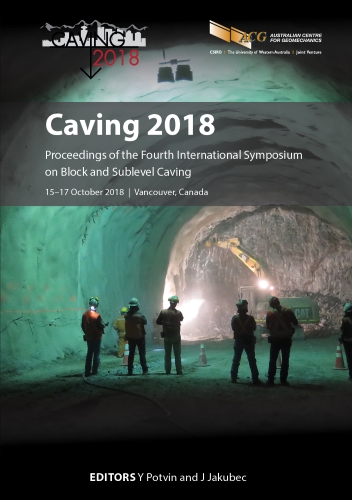Geotechnical data collection and approach to modelling for the Cukaru Peki deposit

|
Authors: Llewelyn, K; Jakubec, J; Goddard, R; Stenhouse, P |
DOI https://doi.org/10.36487/ACG_rep/1815_62_Llewelyn
Cite As:
Llewelyn, K, Jakubec, J, Goddard, R & Stenhouse, P 2018, 'Geotechnical data collection and approach to modelling for the Cukaru Peki deposit', in Y Potvin & J Jakubec (eds), Caving 2018: Proceedings of the Fourth International Symposium on Block and Sublevel Caving, Australian Centre for Geomechanics, Perth, pp. 783-796, https://doi.org/10.36487/ACG_rep/1815_62_Llewelyn
Abstract:
A geotechnical model is the fundamental basis for the design of an open pit and underground mine. A fully understood and representative geotechnical model will provide information on the engineering characteristics of the rock mass, defining how it is going to behave during mining. The model is composed of individual domains, each comprised of materials exhibiting internally similar geotechnical properties. Defining these domains and fully understanding what is critical to the excavation and the associated risks will enable the mine planners to design the optimal mine. A geotechnical model that will add value to a mine design should be developed based on a thorough understanding of the 3D geology, structure and, where relevant, alteration and weathering states of the deposit and how these impact the engineering properties. The geotechnical specialist should have a good understanding of the risks and limitations of each individual model and how these will impact on developing the geotechnical domains. A representative geotechnical model is only as good as the data that is available for the deposit. This paper presents the different types of data used to develop the geotechnical model for the Cukaru Peki deposit and the approach adopted for creating a representative geotechnical model that was used for mine planning.
Keywords: geotechnical data collection, geotechnical model, Cukaru Peki
References:
acQuire Technology Solutions Pty Ltd 2018, GIM Suite, computer software, acQuire Technology Solutions Pty Ltd, Applecross, https://www.acquire.com.au/gim-suite/
ARANZ Geo Ltd 2016, Leapfrog Geo, version 4.1.1, computer software, ARANZ Geo Ltd., Christchurch, http://www.leapfrog3d.com/products/leapfrog-geo
Barton, N 1988, ‘Rock mass classification and tunnel reinforcement selection using the Q-System’, in L Kirkdale (ed.), Rock Classification for Engineering Purposes, ASTM STP 984, American Society for Testing and Materials, Philadelphia, pp. 59–88.
Laubscher, DH 1990, ‘A geomechanics classification system for the rating of rock mass in mine design’, Journal of South African Institute of Mining and Metallurgy, vol. 90, no. 10, pp. 257–273.
© Copyright 2025, Australian Centre for Geomechanics (ACG), The University of Western Australia. All rights reserved.
View copyright/legal information
Please direct any queries or error reports to repository-acg@uwa.edu.au
View copyright/legal information
Please direct any queries or error reports to repository-acg@uwa.edu.au
